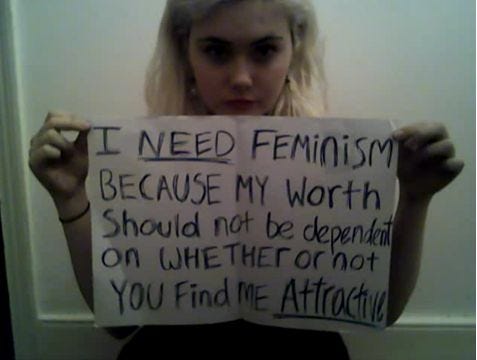'I'm just a girl!' Close - you're fetishising yourself for the male gaze!
Hyper femininity is back: spoiler - it's not feminist
‘I’m just a girl 🤭’ – it sounds like liberation, until you realise it’s a slogan for soft-core conservatism. What started as a trend where girls excused their silly and slightly idiotic actions as it just being in their nature, has become a way of shrinking your self-worth to fit the limitations of womanhood as defined by the male gaze. There is a cultural shift overcoming our society – and it’s not toward progress. We’re regressing back toward hyper-feminised, domestic, quiet womanhood. A return to ‘traditional values’, wrapped in TikTok trends and pink bows.
While this trend started as somewhat liberating – allowing women to reclaim and showcase that just because things are inherently girly doesn’t mean we can’t enjoy them – has transformed into strategic softness. The desirable woman of this generation isn’t the boy’s girl, it isn’t even the girl’s girl, it’s the ditzy bimbo who plays dumb and doesn’t demand anything from men – not even accountability. It’s reducing women to their role to serve men.
No one is just a girl. That phrase is rooted in patriarchy – reducing us to our gender and what we’re allowed to be because of it. Being a girl should never have to resort to living for a man – because being a girl is a beautiful thing.
“All of these women are Barbie, and Barbie is all of these women [...] I’m just so damn tired of watching myself and every single other woman tie ourselves in knots so that people will like us.”
(Barbie, 2023)
The trends that have encompassed my TikTok feed include girl math, girl dinner, and the clean girl aesthetic. These are not just trends though – they’re coded messages: Don’t think too hard or eat too much. Be pretty, be pleasant, and be passive. While ‘girl dinner’ first appeared as liberating, showing that women don’t always have to fit the narrative of domestic cooking, it just painted a light on us as being stupid. Not only that but it glorifies under-eating. The appeal of girl dinners being small amounts of hardly anything romanticises the idea that we don’t need healthy and balanced diets – because we’re just girls!
Girl math also glorifies the stupidity of women, focussing on the idea that because we like to shop, we therefore have no financial awareness and need to come up with stupid reasons to justify unreasonable purchases. We’re just girls, we need men to help explain budgeting to us! Even the clean girl aesthetic prioritises minimalism, we’re clones in slicked-back ponytails, stripped of critical thought – all in the name of girlhood.
TikTok also has seen the rise of more overt examples of this ‘soft’ submission to the male gaze. The rise of trad-wives and homemaking vlogs romanticise the past, especially the 1950s, when women ‘knew their place’. I mean how many times have you seen Nara Smith make a whole grilled cheese from scratch simply because her husband or her kids asked for one. Or seen girls begging to have lobotomies because they feel insane, when it was one of the most traumatic and dehumanising things a woman could be subjected to. While some argue it’s just a lifestyle, it’s telling how it resurfaces right as women gain more financial and societal independence.
‘Girl’ trends and ‘girl’ culture reveals the societal pressure on women to be in a constant state of improvement. Where’s ‘boy dinner’? or ‘man math’? Men don’t feel the same pressure to aestheticise or self-deprecate to be likeable. Women are taught to either be exceptional or adorably flawed – but never simply human.
Some may think it’s empowering – maybe they think ‘just a girl’ celebrates womanhood and the things only a woman can understand. If that was the case then why did the trend never take on the angle of voicing the sexual violence women face, or the treatment they have in the workplace? Because that isn’t appealing to men, and once again, men are what women are living for.
Many of these trad-wife influencers and Mormon influencer families grow up and raise their families with the same education that was given to children in the past. Much less women in those backgrounds are going to college and instead getting married and having children so her ‘duty in life’ can finally begin. 30% of Latter-Day Saints women begin a college education, but do not graduate. Yet many people support them without knowing this because they fit into the aesthetic.
Women’s reproductive rights, the rise in domestic violence, pay gaps and discrimination are conveniently left out of girl culture. Why? Because rage isn’t feminine, it isn’t appealing to the male gaze or the aesthetic.
These important topics are instead getting switched out for conservatism and toxicity. In Gen Z particularly there has been a rise for conservatism, with more movies and shows opting for a lack of nudity or sexual freedom. This isn’t out of the blue either, it’s the chain-link of events that follows this aestheticism of traditional girlhood. Women taking hold of their sexuality was threatening to men and their power and so it is getting left in the early 2000’s. Next thing we know, everyone will be dressing up like Rory Gilmore in the Donna Reed episode and it will be the new normal.
I’m just a girl!
This isn’t empowerment. This is packaging. This is regression disguised as femininity. And worst of all, it’s voluntary – we’re doing it to ourselves because it feels safer than fighting back.
Everyone supports ‘I’m just a girl’ until it means discussing women’s rights.










Saving this one! Nice work!
i hate weaponized incompetence so much. people needed to hear this 💔